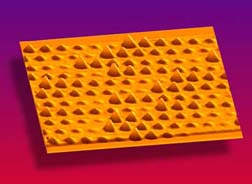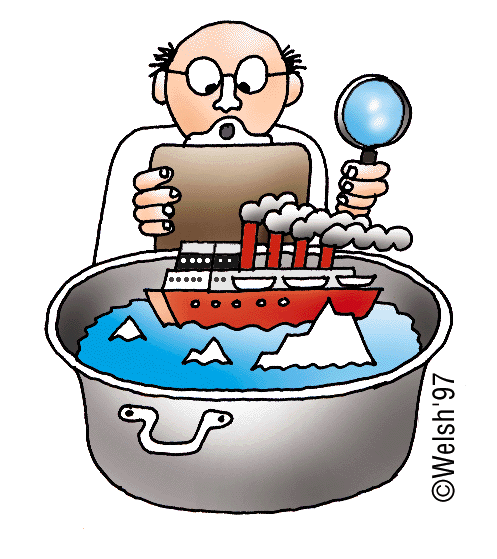|
|
|||
|
|||

|
|||
| Technology at a Glance is a quarterly newsletter from the National Institute of Standards and Technology reporting on research results, funding programs, and manufacturing extension and technology services. If you have comments or general questions about this newsletter or if you would like to receive the four-page, color newsletter in hard copy, please email your mailing address to Gail Porter, editor or call (301) 975-3392. About Technology at a Glance. | |||
In this Issue . . .Articles:CD Storage Disk Holds More Data Infrared Images Track Molecules Building a Better Heat Detector Baldrige 'Index' Is a Winner Method Speeds Up Molecular Modeling New Mini Display Shows Its Colors Neutrons Tackle Materials Stress |
Shorts:
Clues to the Titanic's Sinking Expanding Polymers Shakin' without Breakin' Reading the Green Tea Leaves
Co-op Corner:
|
||

CD Storage Disk Holds More Data |

Digital video disks (DVD), now emerging on the U.S. market, can hold a full-length movie on a single CD. What's next? Calimetrics Inc. hopes it has the answer. The Emeryville, Calif., company has used co-funding from NIST's Advanced Technology Program to create a new compact disk data storage technology that allows a full-length HDTV (high-definition television) movie to be stored on a single CD. The lasers in current disk drives read tiny pits in the plastic CD materials. The lack of a pit edge is read as a 0 and the presence of a pit edge is a 1. A seemingly endless stream of 0s and 1s then encodes all the sounds and pictures on a CD-ROM. Calimetrics' system uses pits of varying depth to allow encoding numbers from 0 to 8. It takes a lot less space to encode information with nine characters than it does with two. This means that the Calimetrics system can fit more sound and picture data in a much smaller space and read the data much faster as well. The colorized graphic above shows a series of peaks of eight different heights that were formed by Calimetrics' master disk-writing system. Such a disk stamper is then used to stamp out plastic CD-ROM-sized disks with pits of varying depth. The peaks are made with a commercial laser-disk-mastering system retrofitted with a Calimetrics power modulator. The modulator works like a dimmer switch with notches--higher power produces higher peaks on the master disk and deeper pits on the finished disks. The company has also retrofitted optical drives to read reliably variable-depth pits from its disks. The company will use private venture capital and funding from corporate partners to develop and market a product using its new technology.
Contact: Tom Burke, (510) 420-1211.
|
||

Infrared Images Track MoleculesA collaboration between NIST and the National Institutes of Health has produced rapid, detailed images that map molecular composition for thin films and biological samples using a custom-built infrared detector array, spectrometer, and microscope combination. While infrared spectroscopy has been used for many years to identify specific chemicals, the NIH/NIST research produced chemical images with a spatial resolution of 10 micrometers in about an hour that would otherwise require days using a conventional Fourier transform infrared spectrometer. The new apparatus uses a 256 by 256 pixel infrared detector array, originally designed for use aboard military missiles, and adapted by NIST for spectroscopic analyses. The array is coupled to an infrared microscope and spectrometer. This enables the collection of infrared spectra from over 65,000 positions of the sample simultaneously. These spectra can be used to create detailed chemical images of a wide variety of materials. The basic technique, originally developed and patented at NIH, requires the use of thinly sliced samples but otherwise is non-destructive. An infrared source illuminates the sample, and the transmitted or reflected radiation is then detected by the array over a wide range of infrared frequencies. Molecules such as proteins, polymers, or lipids absorb some of the infrared radiation at very specific frequencies that serve as "fingerprints" for spectral identification. The colorized graphic above shows a cross-section of a mouse brain imaged with the NIH/NIST apparatus. Bright regions in the image represent areas of the brain with high levels of lipids, while darker areas have relatively higher levels of proteins. These chemical images are being used by NIH in studies ranging from basic research to the analysis of diseased tissues. The research groups expect the new apparatus to be useful across a wide range of industrial and biomedical applications.
Contact: Ted Heilweil, (301) 975-2370 or E. Neil Lewis, (301) 496-6847.
|
|||
Building a Better Heat DetectorFingernails scratching chalkboard, pens that don't write, the neighbors' security system that regularly sets off false alarms whenever they're not home. At least one of life's little annoyances may become a little less common thanks to a new NIST technology. NIST researchers have developed an improved pyroelectric detector, which, in turn, may improve the performance and reduce the cost of products like burglar alarms, infrared motion detectors, automotive pollution sensors, and a variety of military applications that depend on smart sensors. A pyroelectric detector contains a material that produces a charge when heated. When a burglar tiptoes into an empty room, his body heat--about the equivalent of a moving 100 watt light bulb--generates current in the detector and sets off the alarm. Unfortunately, ordinary sounds like a dog barking in the basement also can set off such alarms. The new detector may be able to reduce false alarms by effectively building two detectors into a single crystal. (A provisional patent for the detector has been submitted.) One side of the detector is protected from light or heat, while the other side is not. Acoustic waves generate currents in opposite directions on each side of the detector that cancel each other out. Changes in light or heat radiation levels only generate a current in the exposed side of the crystal and set off the alarm. The result is potentially fewer false alarms.
Contact: John Lehman, (303) 497-3654.
|
|||
Baldrige 'Index' Is a WinnerA new NIST stock investment study shows once again that quality management can yield impressive returns. NIST "invested" a hypothetical $1,000 in the Standard and Poor's 500 and in each of the publicly traded companies which have won the Malcolm Baldrige National Quality Award from 1988-1996.The investment was tracked from the first business day in April of the year the Baldrige winners received the award (or the date they went public) to Dec. 2, 1996. As a group, the 16 companies outperformed the S&P 500 by about 3 to 1, a 325 percent return on investment compared to a 112 percent return for the S&P 500. For a copy of the study go to website http://www.quality.nist.gov or call (301) 975-2036.
|
|||

Method Speeds Up Molecular ModelingA new approach to molecular dynamics modeling developed by Moldyn Inc., Cambridge, Mass., with co-funding from NIST's Advanced Technology Program, produces simulations of molecular movements and properties 100 times faster than conventional methods. The new technique relies on substructuring, which organizes groups of similarly behaving atoms into interacting flexible bodies, to cut dramatically the number of calculations needed to estimate the behavior of large molecules such as proteins. The method was adapted from aerospace modeling techniques used to account for forces on hundreds of thousands of parts in spacecraft and satellites. Conventional, atom-by-atom, molecular dynamics programs can require weeks to months to calculate the behavior of a few molecules. Moldyn's "multibody" approach, known as MBO(N)D, subdivides a large molecule into a few interacting bodies to generate simulations that show excellent agreement with all-atom-based methods but that can be produced much more quickly. The graphic above compares the results from Moldyn's analysis of a DNA molecule (right), versus a more conventional all-atom-based program. The multibody method already has been tested with a pharmaceutical modeling program to help improve the realism of drug/protein interaction simulations. Drug companies use databases containing hundreds of thousands to millions of different molecules and molecule fragments to look for potential medicines. Moldyn's software may allow more efficient screening of these large databases to find molecules that can dock successfully with the active sites on proteins. The result would be faster, less expensive drug development. The 15-person company hopes to join forces with a major software distributor to begin marketing an initial commercial version of its software this fall. Meanwhile, Moldyn is developing ways to automate the substructuring of large molecules so the technology will be more user friendly and accessible to a much wider range of potential users.
Contact: Frank Billingsley, (703) 243-6613.
|
|||
New Mini Display Shows its ColorsYou are flying cross-country to a business meeting and typing a confidential memo to your boss on your sub-notebook computer. You don't worry about the person next to you reading your memo because the screen for your computer is embedded in a pair of ordinary-looking half glasses that puts the text in front of your eyes only. Displaytech Inc. of Longmont, Colo., hopes this image of the future will include their new "image on a chip" display technology.With co-funding from the NIST Advanced Technology Program, the company has developed a way to produce low-cost, high-resolution color displays that are only about as big as a thumbnail. The key to the company's technology is a new type of liquid crystal that "switches" on and off in less than 50 microseconds. Conventional flat-panel displays use patterns of red, green, and blue pixels to create all the colors of the rainbow. The "ferroelectric" liquid crystals in Displaytech's system create the same colors in one-third the space by filling each pixel with light from red, green, and blue light-emitting diodes (LEDs). The crystals are switched on and off so fast the eye blends these pure colors into specific hues like mauve or chartreuse. This allows the Displaytech displays to look less "grainy" and produce much higher resolution than possible with previous technologies. The new displays also can be manufactured substantially cheaper than current "active matrix" displays. The underlying very large scale integrated circuitry that controls the displays uses standard "foundry" technology on silicon wafers versus the custom thin-film transistor processing required by conventional flat-panel displays. Finally, the new displays use light at least 10 times more efficiently than conventional systems, providing a brighter display. Significant power efficiencies also assure longer battery life.
Contact: Christopher Locke, (303) 772-2191.
| |||

Neutrons Tackle Materials StressToo much stress can make a person "crack" under the strain. Too much stress in materials can literally make them crack. Yet just as some stress is unavoidable in life, some mechanical stress is unavoidable in materials. One of the goals of materials researchers is to find ways to both reliably measure stress and to predict what stress levels will cause metal or ceramic parts to fail. This work is particularly important for pipelines, support beams, railroad rails, or other critical applications where a materials failure could cause lost lives.NIST researchers recently completed construction of an instrument at the NIST research reactor that gives materials scientists an atomic-level view of mechanical stress in metal and ceramic parts. The double-axis diffractometer for residual stress, or DARTS, performs stress measurements about five times faster than an earlier instrument. DARTS uses neutrons from the reactor as probes to help find variations in the spacing of atoms in crystalline materials. The graphic above shows the results from DARTS measurements on a section of pipe. Red areas are under tension (being pulled apart), blue areas are under compression (being pushed together), and green areas are in between. NIST researchers expect that an important result of this research will be development of a Reference Standard for testing and calibrating portable X-ray and ultrasonic instruments, which could then be used in the field to measure stress in airframes, railroad rails, or pipelines. Contact: Paul Brand, (301) 975-5072. | |||

|
|||

Clues to the Titanic's SinkingMore than 80 years after a collision with an iceberg sank the "unsinkable" RMS Titanic in the North Atlantic, questions still abound about what happened and why. NIST metallurgists are cooperating with other organizations to analyze pieces of the ship's steel hull and try to determine why the collision caused the ship to sink so quickly. The researchers are thoroughly characterizing thumb-sized samples of the hull for resistance to tearing, fracture toughness, and existence of contaminating elements in the steel's microstructure. They also are comparing their results with similar measurements from hull samples of three other ships that were made by the same shipbuilder as the Titanic with steel from the same foundry. The comparison will help determine whether the steel used for the Titanic's hull was of standard quality for the time. Results of this analysis will appear in a scientific journal later this year. Contact: Timothy Foecke, (301) 975-6592. |
|||
Expanding PolymersMost plastics shrink during the curing process used to make them. The liquid starting materials for making plastic contain short molecules called monomers. The monomers link together in long chains called polymers during curing, and the volume of the plastic shrinks as it hardens. This is very good if you are making shrink wrap for protecting products and very bad if you are making dental restorations. With too much shrinkage a polymer tooth filling will develop gaps and will no longer adhere to the tooth. NIST materials scientists have developed an inexpensive "one pot" process for making a chemical additive that can help prevent polymer shrinkage. The chemical is a special kind of monomer that expands as it hardens. The monomer starts out with a ring structure that opens to form long, crosslinked chains during solidification. By adding some of these "spiro orthocarbonate" monomers to traditional dental monomers, the researchers produced a composite material with very low shrinkage and good mechanical strength. The new monomers also may be useful for making more reliable adhesive coatings and microelectronics packages.
Contact: Jeffrey Stansbury, (301) 975-6790.
|
|||
Shakin' without Breakin'The value of shock absorbers is obvious to anyone who has experienced the bone-jarring ride of the average American school bus. Now, building designers are applying the concept of shock absorbers to buildings in earthquake-prone areas in hopes of saving lives and preventing property damage. These "seismic isolation systems" protect a building from strong ground shaking by inserting a flexible rubber layer or a series of sliding panels between the foundation and the rest of the building. NIST building researchers recently developed performance guidelines for the devices. New testing standards, based on the NIST guidelines, will define minimum levels of reliability and capacity. The sale of "off-the-shelf" isolation systems then could become a reality. Approval of testing standards by the American Society of Civil Engineers is expected by the end of the year.
Contact: Andrew Taylor, (301) 975-6078.
|
|||

Reading the Green Tea LeavesScientists have known for many years that people with diets high in certain foods are less likely than others to get certain types of cancers. Sorting out exactly what compounds in these foods and what amount of the food provide the apparent protective effect is a long-term, difficult undertaking. Working in cooperation with the National Cancer Institute, NIST chemists have several ongoing projects contributing to this research, including a new effort to improve ways of measuring the concentration of catechins in blood plasma. Catechins are compounds found in green tea and are thought to prevent certain human cancers. NIST chemists are developing methods to accurately measure concentrations of specific catechins in green teas using a variety of techniques (capillary electrophoresis (CE), liquid chromatography (LC), and LC/mass spectrometry.) The application of this research to the measurement of catechins in blood plasma should be useful to clinical researchers investigating links between tea consumption and cancer prevention.Contact: Jeanice Brown Thomas, (301) 975-3120. |
|||

Microscope Stage--A new scanning electron microscope stage, jointly developed by NIST, E. Fjeld Co., of North Billerica, Mass., and SEMATECH, will permit chip makers and other SEM users to cover nearly all angles when examining their samples. The new stage doubles the viewing range of typical SEMs and increases the tilt to better than 90 degrees from the horizontal, as compared to the current 60 degrees. Such improved performance capabilities are expected to increase the utility of SEMs as measurement and research tools. NIST has been working with SEMATECH, the consortium of U.S. chip makers and their equipment suppliers, to improve the measurement performance of SEMs and other microscopes used in semiconductor manufacturing.
Contact: Michael Postek, (301) 975-2299.
Global Standards--The Global Standards Network is officially open for business. The network is a World Wide Web-based (http://www.nssn.org) comprehensive source of information on regional, national, and international standards from private-sector organizations and federal government agencies. The network links the heterogeneous databases of these groups, giving users the ability to search many standards databases in a few minutes. Information on more than 100,000 standards--including about 30,000 military specifications--will be in the database by year's end. The new service is the result of a partnership between the American National Standards Institute and NIST, with initial funding from the Defense Department's Technology Reinvestment Project.
Contact: Belinda Collins, (301) 975-6455.
Inspecting Pipes--NIST researchers have received a patent for a new method of measuring wall thickness and detecting flaws (such as cracks, and corrosion) in natural gas pipelines by using ultrasound. Use of ultrasound inspections is common for oil pipelines but has been less effective for the natural gas variety. The NIST researchers showed that use of high-quality ultrasound transducers coupled with high- performance transmit-receive electronics can overcome the signal losses typical in the past. NIST is working with the Southwest Research Institute, under a contract with the Gas Research Institute, to show the practicality of the method. Contact: Chris Fortunko, (303) 497-3062. |
|||
About Technology at a Glance:NIST is an agency of the U.S. Department of Commerce's Technology Administration. NIST promotes U.S. economic growth by working with industry to develop and apply technology, measurements, and standards. Technology at a Glance is produced by Public and Business Affairs, A903 Administration Bldg., NIST, Gaithersburg, Md. 20899-0001. Any mention of commercial products is for information only; it does not imply recommendation or endorsement by NIST. Technology at a Glance Editor: Gail Porter, (301) 975-3392, email: gail.porter@nist.gov. For patent information, call (301) 975-3084. |
|||

